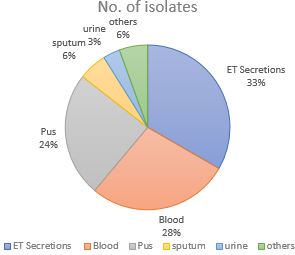Candida and Aerobic Bacterial Isolates with Antibiotic Susceptibility pattern from vaginitis among Reproductive age group women in a Tertiary Care Center, a Retrospective Analysis
Abstract
Introduction: Vaginitis, a common clinical condition among women of reproductive age, results inconsiderable morbidity. This study aimed to analyze the frequency of Candida and aerobic bacterialisolates from the vagina with antibiotic susceptibility testing.
Methods: A retrospective study wasdone in a tertiary care center, South India, Kolar. Data was collected from one year. Two high vaginalswabs collected were subjected to Gram staining, culture. The isolate was identified phenotypically,and an antibiotic sensitivity test was performed.
Result: Prevalence of aerobic and Candidalvaginitis is 19.43% in the age group of women between 16 to 53years. The majority of the subjects,50.8%, belongs to the 21-25yrs age group, and the highest positivity was seen among women in theage group 16 to 20 years. Of the 97 isolates, bacterial isolates included 60(61.85%), 37(38.15%)had Candida species. The most common etiological agent in aerobic vaginitis was Escherichia coli (EColi), followed by Staphylococcus aureus. 35(94.60%) were Candida albicans, 1(2.70%) each wasCandida krusei and Candida paropsilosis Gram-negative organisms showed more sensitivity toCarbapenems, least sensitivity was seen among Ampicillin, third-generation CephalosporinPiperacillin and Ciprofloxacin.
Conclusion: Gynecological conditions like vaginitis and vaginosiscauses severe morbidity and mortality especially in pregnancy which needs to be addressedappropriately and adequately hence identification of the etiologic agents becomes the necessity toprovide adequate and appropriate treatment
Downloads
References
2. Mulu W, Yimer M, Zenebe Y, Abera B. Common causes of vaginal infections and antibiotic susceptibility of aerobic bacterial isolates in women of reproductive age attending at Felegehiwot Referral Hospital, Ethiopia: a cross sectional study. BMC Women’s Health. 2015; 15:42.
3. Donders, G.G., Vereecken, A., Bosmans, E., Dekeersmaecker, A., Salembier, G. and Spitz, B. Definition of a type of abnormal vaginal flora that is distinct from bacterial vaginosis: aerobic vaginitis. BJOG: An International Journal of Obstetrics & Gynaecology. 2002; 109: 34-43.

Copyright (c) 2022 Author (s). Published by Siddharth Health Research and Social Welfare Society

This work is licensed under a Creative Commons Attribution 4.0 International License.


 OAI - Open Archives Initiative
OAI - Open Archives Initiative


